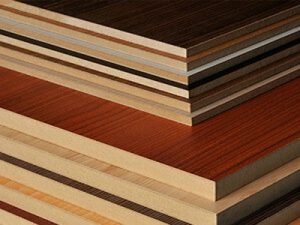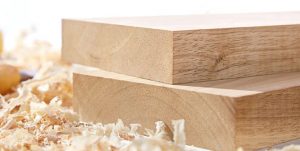Knowledge points about wooden based board and plywood, series seven.
- Pre-pressing repair secondary hot pressing process
Process: single gluing of medium plate → two medium plate and core plate group blank → slab prepressing → mending → hot pressing → mending → aging and shaping → sanding and thickness fixing → surface and backplane hot pressing veneer. - Laminated veneer
Process flow: log → wood section preparation → rotary cutting → veneer → shear → miter → glue pressing interface → drying → glue coating → group blank → prepressing → (truncation) → hot pressing → cutting saw - Plywood raw materials
(1) Preservative requirements for wood-based panel industry
① To a variety of fungi, bacteria and insects are lethal, but in the process of treatment, do not make people, livestock poisoning and environmental pollution;
② Good chemical stability, not easy to volatilize, and will not encounter water loss;
③Good coordination with adhesive, does not affect the secondary processing such as bonding and finishing;
④ The raw materials are widely available and the price is cheap.
(2) The main veneer materials are: veneer, melamine impregnated paper, decorative board (plastic stick panel), polyvinyl chloride plastic material (PVC),melamine film and other decorative materials
(3) Thin wood classification according to the form is divided into natural, combination, integrated, dyed, rolled into five.
(4) Thin wood species:
General requirements are more obvious wood in the morning and evening, thick or dense wood ray, can form beautiful wood grain in the diameter or chord section of the tree; It should be easy to cut, glue and finish. For broadleaf wood, the diameter of its conduit should not be too large, or it is easy to be broken after being made into thin wood.
(5) Classification of base paper: according to different uses, it can be divided into surface paper, decorative paper, covering paper and bottom paper.
(6) the problems that should be paid attention to in establishing land-based lumber yard: first, keep high moisture content as far as possible; The 2nd, brush protect wet anticorrosive material in lumber two ends besmear, can prevent moisture to evaporate, still it has anti-corrosion properties.
(7) Main peeling methods in plywood production:Cutting type peeling machine. Cutting type peeling machine according to the direction of bark peeling can be divided into longitudinal cutting, transverse cutting and spiral cutting and other three forms.
(8) Sawing principle:According to the material, defect concentration, cut bend straight, reduce the broken head, good material is good, the use of the material. The size of wood section should be in accordance with the length and width of the plywood and the processing allowance and dry shrinkage allowance.
(9) the purpose of peeling: bark can not be spun into veneer, bark fiber is easy to plug the knife door; Rough bark, containing silt, metal, will destroy the rotary knife; Spinning bark is a waste of energy.
(10) Peeling requirements: peeling completely, without xylem damage; High stripping efficiency, less energy consumption; Can adapt to different diameter, tree species, shape of the wood segment.
(11) peeling method: mechanical peeling; Hydraulic peeling; Manual peeling.Request a Quote - Movement of moisture in plywood.
(1) The existence form of water in wood: free water, combined water and combined water.
(2) Water movement passage ① Longitudinal passage: water moves along the cell cavity in a parallel fiber direction and is discharged from the two end faces (length direction) of wood. ② Transverse passage: water moves perpendicular to the fiber direction along the pore in the cell wall. (Mainly horizontal).
(3) The force of water movement in wood ① capillary tension. Liquid or steam pressure difference. ③ Moisture content gradient.
(4) drying process moisture movement process, (1) heat transfer process under the action of temperature, heat first transferred to the basic unit surface and gradually to the internal transfer process. Under the action of heat and water vapor pressure difference, the water in the basic unit continuously diffuses to the surface, this diffusion process is called internal diffusion. The evaporation process and internal diffusion process of basic unit surface water are called mass transfer process.
(5) Water conduction mode, ① Liquid water: moving along long continuous microcapillaries. ② Water vapor: moving along the large capillary composed of cell cavity and pore. Liquid and gaseous phases are constantly interlaced, moving along adjacent microcapillaries and cell lumens.
(6) The nature of dryness,Under the action of dry medium, through the heat and mass transfer process, free water and suction water in the evaporation unit, so that it meets the requirements of production technology. - Characteristics of veneer.
(1) Beautiful and real, feel good, good view.
(2) processed into thin wood, can save rare and high-quality wood, increase its use efficiency.
(3) Can be parquet, form a more beautiful image.
(4) veneer method is simple, low cost and high price, veneer value added 1~1.5 times, good benefit.
(5) The disadvantage is that large diameter level logs need to be consumed, and the anti-pollution force of decorative surface is poor. - Precautions for wet veneer pastes.
(1)The viscosity of the adhesive should be large, and there should be a certain initial viscosity, otherwise the thin wood is easy to move.
(2) The joint should be strictly two pieces of wood, so as not to cause the seam.
(3) Veneer should not be taut when collage, and there should be a shrinkage margin, because the veneer will shrink with the evaporation of water when hot pressing.
(4) When collage the thin wood with a thickness greater than 0.5mm, it is best to temporarily fix the back with adhesive tape first, and sand the adhesive tape away after hot pressing.
(6)Waterproof agent function: used to improve the water resistance of board products, improve dimensional stability, reduce or eliminate wet expansion and dry shrinkage.
Warping deformation and prevent products due to moisture absorption caused mildew and enhanced electrical conductivity. - The wood segment can be divided into four parts :(1) broken veneer part (2) long veneer part (3) continuous veneer belt part (4) remaining wood core part.
- Advantages of steel belt flat continuous press :(1) small thickness deviation; (2) High productivity; (3) less trimming loss; (4) High utilization of heat energy; (5) low power consumption; (6) Good product quality.
- Request a Quote


